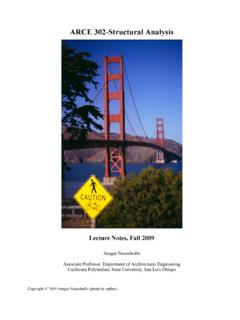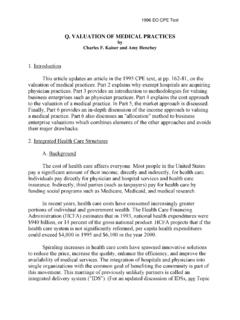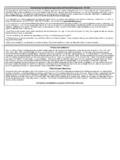Transcription of Why Student Debt May Kill the Future of Medicine
1 Why Student debt May Kill the Future of MedicineKnowledge Is No Longer PowerKevin ReeceCal PolyMarch 2010 Introduction: Money is tight an all too common phrase heard in today s world of financial burden and uninspiring economy. I want you to imagine that money really is tight, and that you owe someone $45 dollars for the groceries you bought last week, that you are living paycheck to pay check, and that you have another child on the way. It s a scary feeling right? And millions of Americans are dealing with it today. Now imagine all of those things again, but instead of owing someone $45 dollars, you owe them a quarter of a million dollars.
2 Welcome to the life of a recent medical school graduate. The Future of Medicine is in jeopardy. medical school tuition has gotten out of hand and students are being forced to take on extreme amounts of debt before they ever earn a penny. medical school tuition has grown by 400% for private schools since 1960 and 250% for public schools, and these figures are adjusted for inflation (Chhabra). According to a study by Family Practice News, although medical school tuition and fees have increased at rates far in excess of inflation, physician income at the same time has remained relatively flat. As one Student put it in an interview with American medical News, such debt loads are "like having a mortgage before you earn your first dollar of income.
3 " The fear of facing incredible quantities of debt is deterring a lot of brilliant students from committing themselves to the medical field. Being forced into massive debt can have devastating economic and psychological consequences. Students from low income or minority families, who are already underrepresented in the medical community, are especially being discouraged to pursue a career in Medicine because of the financial implications. AAMC Senior 1 Associate Vice President H. Paul Jolly, claims that, "Right now, people with parental incomes in the top 20 percent of families are making up 55 percent of medical school students.
4 If present trends continue, this imbalance will only worsen. The fact is, debt is incredibly scary. Students who do end up going to medical school are facing debt well into the six-figures. According to Family Practice News, the median indebtedness of medical school graduates has increased dramatically during the last 20 years--from $20,000 for both public and private schools in 1984, to almost $140,000 and $100,000 for private and public schools, respectively, in 2004. Georgetown medical Student Mary Vigil told President Obama she would have about $300,000 in debt when she graduated from medical school.
5 Large amounts of debt are causing young doctors to overwork themselves after graduation, merely to survive while they begin to chip away at their enormous amount of owed money. Sometimes, paying back the debt can take 20-30 years. The stress and preoccupation with debt can lead to poor patient care, drug addiction, ruined family lives, and ultimately burning out at a young age. Not only are medical Student being affected by the increasing medical school tuition, but the general population will soon be able to feel the effects as well. High tuition rates are deterring Student from entering the medical field and this is leading to shortages.
6 These shortages are hitting the primary care sector the hardest, and a simple visit to the doctor may soon feel like a crowded and anxious experience at the DMV. Will the downward spiral of increased tuition and debt continue or can something be done? Although the issue starts at the school with decreasing tuition, there are other pieces to the Problem With debt :Many problems arise from the large amounts of debt that young medical students are faced with. When medical students eventually land a job, they are forced to overwork themselves in hopes of making a little bit more money to help pay for their debt .
7 Overworking can lead to a number of things including mistakes in the workplace due to lack of sleep and eventually even burnout where there is no longer any enjoyment in the practice of Medicine . Burnout is defined as "a pathological syndrome in which emotional depletion and maladaptive detachment develop in response to prolonged occupational stress," (Thomas). One solution new physicians frequently result to in order chip away at their debt is called moonlighting. Moonlighting occurs when a recent medical school graduate is in their residency program and they decided to take on a second job as a physician, usually in an emergency room.
8 Keep in mind that residents already work 80+ hour weeks. On top of their 80+ hour work week, this recent graduate is also making life or death decisions at a hospital all night just to be able to pay rent! Physicians can develop drug dependence issues if they are taking caffeine supplements to stay awake and work long hours. When caffeine is no longer doing the trick, some may even resort to amphetamines to stay up longer and earn a few more bucks. Spending most of their time at the hospital and not enough at home, doctors are often known for having a dysfunctional family life. debt also has the ability to divide physicians in a community where physicians, more than anybody, must stand united.
9 If you and I are both doctors in need of money, and I 3take an extra shift that you wanted so you could afford to buy your daughter a birthday present, controversy is inevitable. How have Doctors managed in the past?There has always been the misconception that physicians make a ton of money and are able to pay off their medical school debt very quickly once they get a job. While this may have been true some time ago, it is absolutely false now. Paying off medical school debt is a career long objective. After malpractice insurance, law suits, and paying loan interest, physicians really do not make as much as most people believe.
10 Going to the military is often suggested as good way to get around the debt of medical school. The military will pay for 100% of your tuition you will be debt free! The only caveat (and by only, I mean incredibly large and life altering) is you owe them 7 years of service. When I first saw this lucrative offer I thought, Seven years isn t too bad; I would be in school for 4 years and then only 3 years of service! Unfortunately, that is not how it works. The 7 years of service begins after your medical residency. This means that if I took the military route I would be in medical school for 4 years, do a residency in the military for 3-6 years, and then finally begin my 7 years of service where I would make less money that a doctor in the civilian world.







